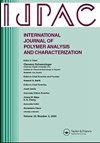基于响应面方法制备食品包装用西米淀粉生物塑料薄膜
IF 1.6
4区 工程技术
Q4 POLYMER SCIENCE
International Journal of Polymer Analysis and Characterization
Pub Date : 2024-10-02
DOI:10.1080/1023666X.2024.2383480
引用次数: 0
摘要
由于塑料具有不可生物降解和难降解的特性,过去几十年中塑料使用量的增加造成了环境污染。这给固体废物管理工作带来了很大的问题。利用天然和可再生成分开发生物可降解聚合物可以解决塑料污染带来的挑战。本研究涉及西米淀粉基生物可降解生物塑料薄膜制备工艺的优化。西米淀粉、甘油-山梨醇混合物和壳聚糖分别用作多糖、增塑剂和抗菌剂。采用响应面法和箱-贝肯设计法进行了因素筛选和优化设计,以研究制备薄膜过程中所有成分之间的相互作用。此外,还通过场发射扫描电子显微镜和傅立叶变换红外光谱对所制备的生物塑料薄膜进行了表征。抗菌药敏试验表明,在薄膜中加入肉桂精油可抑制枯草芽孢杆菌和粪肠球菌 XF1 的生长。此外,开发的薄膜还成功地减少了包装面包样品上真菌的增殖。微生物分析发现,小麦面包的保质期从 3 天延长到了 15 天。本研究开发的西米淀粉生物塑料薄膜有可能满足食品包装薄膜的要求。本文章由计算机程序翻译,如有差异,请以英文原文为准。
Response surface methodology-based preparation of sago starch bioplastic film for food packaging
The increase in the use of plastics during the past few decades has caused environmental pollution due to the non-biodegradable and recalcitrance nature of the plastics. This has caused great problems for the solid waste management efforts. The development of biodegradable polymers from natural and renewable ingredients can address the challenges caused by plastic pollution. The present work deals with the optimization of the preparation process of sago starch-based biodegradable bioplastic films. The sago starch, glycerol-sorbitol mixture, and chitosan were used as polysaccharides, plasticizers, and antimicrobial agents, respectively. The factors screening and design optimization were performed using response surface methodology and Box-Behnken Design to investigate the interactions between all components in the film preparation. Furthermore, the developed bioplastic films were characterized through field emission scanning electron microscopy and Fourier transform infrared spectroscopy. The antimicrobial susceptibility assay showed the inhibition of the growth of Bacillus pumilus and Alcaligenes faecalis XF1 by incorporation of cinnamon essential oil into the film. Moreover, the developed films successfully reduced the proliferation of fungal growth on packaged bread samples. The microbial analysis found that the shelf life of the wheat bread was improved from 3 to 15 days. The sago starch bioplastic films developed in this study can potentially meet the requirements for food packaging films.
求助全文
通过发布文献求助,成功后即可免费获取论文全文。
去求助
来源期刊
CiteScore
3.50
自引率
5.30%
发文量
37
审稿时长
1.6 months
期刊介绍:
The scope of the journal is to publish original contributions and reviews on studies, methodologies, instrumentation, and applications involving the analysis and characterization of polymers and polymeric-based materials, including synthetic polymers, blends, composites, fibers, coatings, supramolecular structures, polysaccharides, and biopolymers. The Journal will accept papers and review articles on the following topics and research areas involving fundamental and applied studies of polymer analysis and characterization:
Characterization and analysis of new and existing polymers and polymeric-based materials.
Design and evaluation of analytical instrumentation and physical testing equipment.
Determination of molecular weight, size, conformation, branching, cross-linking, chemical structure, and sequence distribution.
Using separation, spectroscopic, and scattering techniques.
Surface characterization of polymeric materials.
Measurement of solution and bulk properties and behavior of polymers.
Studies involving structure-property-processing relationships, and polymer aging.
Analysis of oligomeric materials.
Analysis of polymer additives and decomposition products.

 求助内容:
求助内容: 应助结果提醒方式:
应助结果提醒方式:


